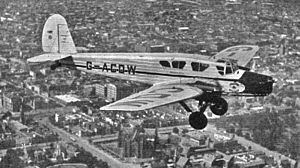Spartan Cruiser
| Cruiser | |
|---|---|
 |
|
| Spartan Cruiser over Melbourne, 1934 | |
| Role | Light Transport |
| Manufacturer | Spartan Aircraft Limited |
| Designer | Edgar Percival |
| First flight | 1932 |
| Introduction | 1933 |
| Retired | 1942 |
| Primary users |
Spartan Air Lines British Airways Ltd |
| Number built | 17 |
| Developed from | Spartan A.24 Mailplane |
The Spartan Cruiser was a 1930s British three-engined transport monoplane for 6 to 10 passengers built by Spartan Aircraft Limited at East Cowes, Isle of Wight. It was a development of the Saro-Percival Mailplane for passenger use.
The Saro-Percival Mailplane was a three-engined monoplane mail plane designed by Edgar Percival, and built by Saunders-Roe Limited (Saro) at Cowes in 1931, the aircraft first flying early in 1932. It was a low-winged monoplane, with a wooden wing and plywood fuselage, and was powered by three 120 hp de Havilland Gipsy III engines. When Saro was financially re-organised, Percival sold his interest in the aircraft to Saro, who re-designated it as the Saro A.24 Mailplane. Due to the close ties between Saro and Spartan Aircraft, the development of the aircraft was transferred to Spartan, and the aircraft was re-designated again as the Spartan Mailplane. The aircraft was modified to accommodate two passenger seats. Starting on 15 June 1932, the Mailplane (G-ABLI) flew from Stanley Park Aerodrome (Blackpool) to Karachi, India taking a total of 5 days 23 hours 50 minutes.
The Mailplane had seen no commercial interest, so the design was re-worked as a passenger carrier. This re-designed aircraft was designated the Spartan Cruiser, and the prototype (G-ABTY) first flew in May 1932, piloted by Louis Strange. The original three-engined low-wing format had been retained, but the plywood fuselage was replaced with an all-metal fuselage to carry six passengers and two crew.
Just one example was built of the basic Cruiser (G-ABTY, later known as the Cruiser I). Both the new Cruiser and the Mailplane were displayed at the first Society of British Aircraft Constructors (SBAC) Show at Hendon Aerodrome on 27 June 1932. It was then used for demonstrations, including a 3,593 mile European sales tour. The Yugoslavia airline Aeroput ordered two aircraft and a licence to build further examples in Yugoslavia at the Zmaj aircraft factory.
...
Wikipedia
